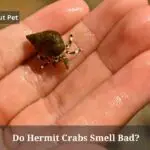Death in living creatures is inevitable. The praying mantis is popular as a pet will enter old age and die after reaching their life span of 6-13 months. But sometimes, several conditions cause mantis to die long before their lifespan, such as poor care, lack of humidity, too cold temperatures, etc.
Praying mantis owners must understand the signs of a dying praying mantis, such as no body movements, no appetite, and changing color. To avoid unwanted things in your mantis, let’s unravel how we know if a praying mantis is dying.

I Think My Mantis Is Dying!! What Should I Do?? URGENT
Every mantis owner doesn’t want to see anything bad happen to their pet. If the mantis shows unusual behavior, mantis owners need to pay attention to any oddities that occur in the mantis.
Some signs when a praying mantis is dying are loss of appetite, decreased activity levels, changes in physical appearance, and altered behavior.
Dying Praying Mantis
One of the obvious signs that a mantis is dying is declining or refusing to eat. It is an alarming sign that your mantis may be experiencing health issues or dying.
Your mantis will remain lethargic due to refusing food, slow movements, and sitting on the ground.
Urgent!!! Is My Mantis Dying?
A weak praying mantis due to food refusal or lethargy is a sign that the mantis is nearing the end of its life.
Mantis do not have the energy to carry out their regular activity because there is no energy from those who do not want to eat.
Mantis’ health is declining over time, and you should take steps to try to feed the mantis directly.
How Do You Save A Dying Praying Mantis?
To help the praying mantis when it looks weak, you must understand the praying mantis dying symptoms. The table below will make it easier for you to recognize when the praying mantis health and vitality are declining.
| Praying mantis dying symptoms | Explanation |
| Loss of appetite | The praying mantis refuses whatever food you give it, it doesn’t want to touch the prey even if it moves in front of it. |
| Remains lethargic | Praying mantis almost doesn’t move, and doesn’t do anything on their tank. |
| Changes in physical appearance | The praying mantis changes color to brown in some parts of the body, is scrawny, underweight, or has difficulty in perching properly. |
| Altered behavior | Praying mantis indicates lack of coordination and inability to perch properly. |
Saving a praying mantis from dying condition is finding what the cause is. If the praying mantis becomes weak due to environmental factors, immediately check the tank temperature, humidity levels, or lighting conditions.
If the mantis experiences insufficient nutrition, you must provide appropriate food and feed it directly. Or if the mantis is already in its life span, there’s nothing you can do, even though the mantis is in the most optimal conditions.
How Do You Tell If A Mantis Is Molting Or Dead?
Many mantis owners are still confused about the difference between praying mantis molting or dying. Molting and dying mantis both exhibit lethargic behavior, but not inactivity.
If the praying mantis experiences prolonged periods of lethargy and inactivity, it’s a sign that your pet is in distress or dying.
Mantis will look for branches or places to hang when molting while dying mantis will not be able to hang due to lack of energy.
How Can You Tell If A Praying Mantis Is Dehydrated?
Praying mantis will show signs of dehydration by rejecting prey in front of them. Mantis will look for water around them and try bending down on your hand to detect your sweat to drink it.
Do Praying Mantis Turn Brown Before They Die?
Praying mantis that experiences fungal infections or parasites will change their body color to brown in certain body parts. But normally, praying mantis will not turn brown before it dies.
What Do You Feed A Dying Praying Mantis?
Praying mantis twitching and not moving much is a sign that they are dying. Any food can be given even if the praying mantis is in a weak condition, such as crickets, fruit flies, ladybugs, and other insects, but use tweezers to direct live prey to the mantis until they take the food and eat it.
Is Dying Praying Mantis Dangerous?
There is nothing dangerous when a praying mantis is dying if it matches its lifespan. Every praying mantis with more than one year old will experience a decline in it’s health and vitality, even though previously mantis were fine.
Praying mantis move after death with their legs twitching occasionally, but there is no movement in their mouth and antennae.
Final Verdict
When praying mantis are dying, they will show symptoms such as refusing food, immobility, altered behavior, and changing color due to infection.
There’s nothing you can do when a praying mantis is dying according to lifespan, but you can help praying mantis to stay healthy when they are affected by health issues.
Check their environmental factors, such as humidity and room temperature and give the praying mantis adequate food.

Welcome to Learn About Pet. My name is Rajkumar Ravichandran and I love all pets, travel, and amazing food. I write about my passion and personal experience caring for multiple pets in this blog! ❤️
Post Disclaimer
DISCLAIMER: THIS BLOG OR WEBSITE, "Learn About Pet", DOES NOT PROVIDE YOU WITH MEDICAL ADVICE AND IS NOT A SUBSTITUTE FOR MEDICAL ADVICE. ALWAYS GET IN TOUCH WITH YOUR PERSONAL VETERINARIAN AND USE INFORMATION HERE AS GENERAL ADVICE.
The information, including but not limited to, text, graphics, images and other material contained on this website are for informational purposes only. No material on this site is intended to be a substitute for professional veterinary advice, food recommendation, diagnosis, or treatment. Always seek the advice of your veterinarian or other qualified health care provider with any questions you may have regarding a medical condition or for pet food related questions.







